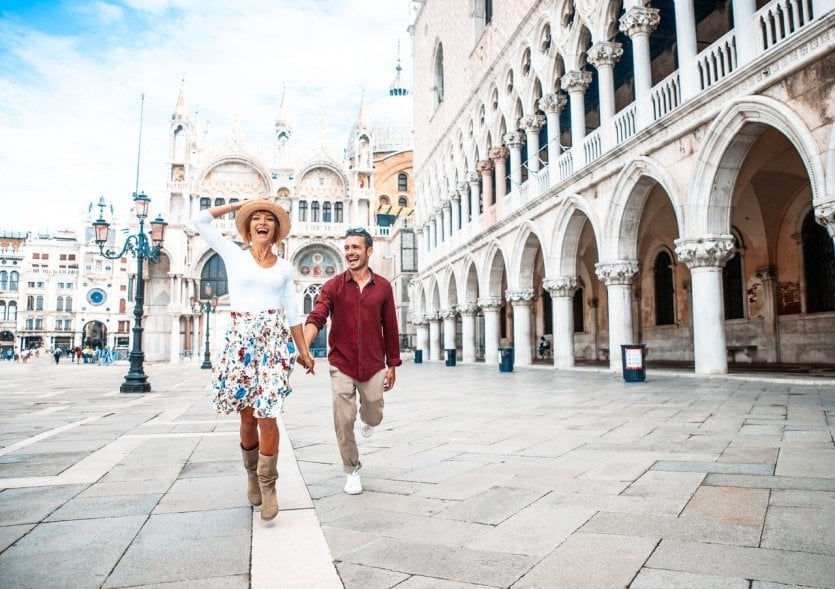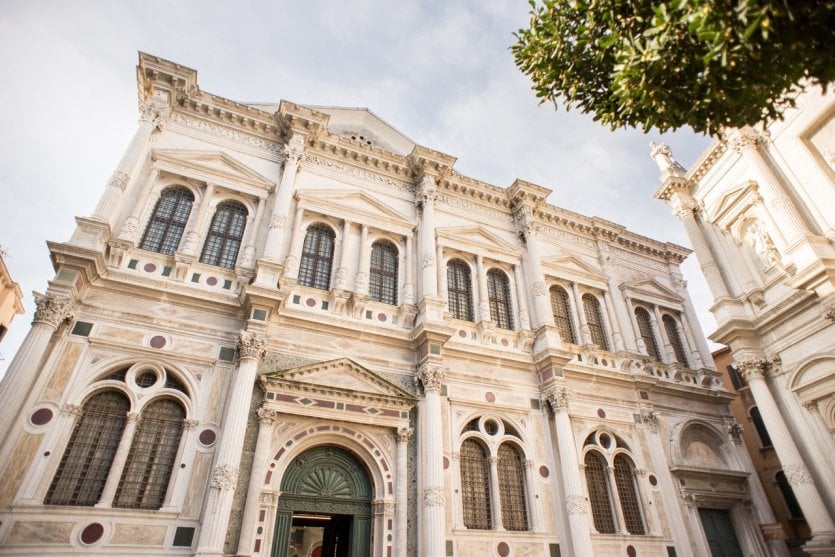© DavideAngelini- Shutterstock.com
Venice is one of the world's top tourist destinations and, if you plan well, you can visit its main attractions in about 72 hours. This itinerary will help you plan your visit to the Venetian islands.
If you have decided to visit one of the most famous destinations in the world, you probably already know that the
things to see and do in Venice are almost endless, so much so that it can be difficult to plan your stay.
To help you make your trip a success, here is an itinerary that will allow you to see the
best of the city in three days . This way, you can return home without having missed any of the highlights of the Serenissima.
Day 1: Discover the main attractions of the San Marco district
Pont Rialto© © S.Borisov - Shutterstock.Com
The San Marco district is
Venice's most famous , not least because it's home to two of its most spectacular monuments: the Basilica and the Doge's Palace.
L'he architecture of this district features some of the most impressive residences on any island, as it was home to the Venetian bourgeoisie. For the first day of your trip, the following itinerary will enable you to discover this part of the city from north to south and east to west.
1) Start the day at the Accademia Bridge
The Accademia Bridge links the southern part of the Dorsoduro district to the south-western end of the
San Marco district. For many experts, this is one of the city's most beautiful and important bridges, due to its
privileged location and particular structure.
It is an arch built of
metal and wood , with a rather elegant design that differs from ancient Venetian architecture. Once you've crossed, walk over to
Campo San Stefano for a stroll in one of the city's most beautiful squares and breakfast in one of the many cafés in the area.
2) See the exteriors of Teatro La Fenice and cross Campo Sant'Angelo
You can't visit the San Marco district without visiting the eponymous square. Along the way, you'll also find a number of
Venice's most important attractions , including the La Fenice theater, a cultural complex renowned for the beauty of its interior, which respects all the aesthetics of Venetian Baroque.
The choice of this route to St. Mark's Square is all the more judicious as these streets
are lined with luxury boutiques and high-end restaurants. You'll get a glimpse of the world associated with the wealth and celebrities who frequent
Venice .
3) Go as far as Piazza San Marco to see the basilica
For many experts, Piazza San Marco is
Venice's greatest historical and architectural treasure . There are countless buildings in the area worth seeing for their importance in the city's past.
One not to be missed is a guided tour of
of St. Mark's Basilica which is offered with entrance tickets. This is one of the most impressive churches in the world and, at the time, it was a very important building for Venice to achieve great cultural influence during the Italian Renaissance.
The church tower, which
functions as an independent structure , is also a site worth visiting, or at least appreciating from the outside.
4) Visit Venice's Doge's Palace
Finally, another place not to be missed before continuing the first day's itinerary is the famous
doge's Palace in Venice.
The building is impressive, both for its beautiful architecture
the very best of Venetian Gothic as for its history. Over the years, it has been the residence of the main leaders of the Venetian Republic, as well as the seat of government, the court of justice and even a prison!
5) Stroll along the Riva degli Schiavoni
Once you've finished visiting the ducal palace, you'll find yourself in a part of the city known as Riva degli Schiavoni.
This long promenade stretches from this part of the San Marco district to the south-eastern end of the Castello quarter.
This is an important area, as it is home to a
large part of the city's docks . It's also home to a wide range of stores and restaurants. An ideal place to dine.
6) End the day with a boat trip on the Grand Canal
Venice's Grand Canal is the space that separates the main island groups. For many centuries, it served as the city's most important commercial transit area.
About 850 m from the start of the Riva degli Schiavoni, it's the perfect place
to enjoy the suns et and continue exploring the beauty that characterizes Venice.
It's then a good idea to
walk to the Rialto Bridge , one of the city's most important attractions. For centuries, this monument was the only way to link the two main areas of Venice. Once there, don't miss the opportunity to take a
guided boat tour along the Grand Canal, an experience that will allow you to see all the monuments along its banks.
Day 2: See the best of the funky Dorsoduro neighborhood
Scuola Grande di San Rocco© ©Booblgum - iStockphoto.com
Venice is a city that has a lot to offer outside of the San Marco district. One of the other interesting areas is Dorsoduro, a neighborhood that for centuries has been
considered the city's
university district .
With this itinerary for the second day of your trip, you will be able to visit the most important buildings of this area known for its youthful identity and its association with the best of Venetian art.
1) Surprise yourself with the art of the Accademia Gallery
You will start your second day in a place quite close to the starting point of the previous day's itinerary. This time it is the Accademia Gallery. This is the museum
where the Academy of Fine Arts of Venice exhibits its collection of local art. A great opportunity to see works by important painters like Titian, Canaletto and Tiepolo.
The area around the museum is full of restaurants and cafes, where it is recommended to have breakfast
if you have not already had it in your accommodation .
2) Reach the Ponte dei Pugni canal
If you cross other small bridges and canals towards the north, you will eventually reach the Ponte dei Pugni. It is a small bridge over a canal that is
practically straight for its entire length . In addition to its beauty, it is recommended because it has a history linked to the struggles that took place between the people who lived on both sides of the canal.
Remember that at the time, street fights functioned
as a means of tax collection by the city authorities, since people paid to participate.
Another reason to visit this bridge is that it offers a
privileged view of one of the most photographed areas of the whole island of the city.
3) Walk around the Scuola Grande di San Rocco and the Basilica of Santa Maria dei Frari
After crossing the famous bridge, you will arrive directly in the area where the Campo di Santa Margherita is located. This part of the city is ideal
if you want to take a break for an authentic Italian coffee or just a bite to eat before continuing your day of sightseeing.
When you feel ready to continue, you will cross another bridge to reach the island where the
Scuola Grande di San Rocco is located, a museum that once belonged to a religious brotherhood and now houses various works
from the Renaissance period .
The Basilica of Santa Maria dei Frari, one of
the most beautiful churches in Venice, is another must-see in this part of the city. It also houses two of the most important works of the painter Titian. This mausoleum is also where his tomb is located.
4) Continue your visit to the Mercato di Rialto and Ca'Pesaro
This is a
lively neighborhood, heavily focused on tourism and for many, the second most important area of the city after San Marco :
- Wander at your
leisure through as many streets as possible and spend enough time in the square of the same name, especially in the beautiful
Palazzo Soranzo , which is located at one end of it.
- Take the opportunity to visit the
Rialto market , the ultimate reference for Venetian markets. You'll find a wide variety of vegetables, fresh produce and
seafood, fish and shellfish.
The whole area is full of gastronomic establishments that try to
follow the best modern trends . It is therefore a good place to dine if you want to enjoy the most innovative proposals of the culinary world in Venice.
Day 3: Discovering Venice's best kept secrets
Burano© ©Catarina Belova - Shutterstock.com
On your third day in Venice, this incredible city still has many secrets to reveal. The following sites are treasures that will help you return home with a better understanding of the beauty of Venice.
1) Excursion to Burano and Murano
In the Venice lagoon is a group of islands that stand out for the beauty of their architecture and
their connection to the art of handcrafted glass .
Visiting Burano from Venice and
Murano is an excellent idea and the most convenient way to do so is to use the excursions that offer round trips from the Cannaregio district.
Here you will find museums dedicated to the art of glassmaking and a wide variety of restaurants and commercial establishments. The advantage of this plan is that you will be
accompanied at all times by a guide specialized in the history of the area.
The lighthouse on the island of Murano and the Basilica of Santa Maria and San Donato are two must-see sites that are usually part of the tour.
Walk the streets of the Hebrew Ghetto
Many cities in Europe have Jewish neighborhoods, directly related to the history of the Jewish community. In the case of the city of Venice, this neighborhood is located in the
district of Cannaregio and extends over a total of five or six streets. It has:
- two synagogues
- a
myriad of kosher stores
- a Hebrew museum that tells the story of the relationship between the Jewish community and the development of the Venetian identity.
This area is also ideal for lunch on the last day, as you will be able to taste typical Venetian recipes, but
with the interesting reinvention that the city's Jewish communities have brought to it over the centuries.
2) Discover the famous Casinò di Venezia
Since you're already in the Cannaregio neighborhood, a five-minute walk of about 400 meters will take you to the Casino of Venice, which
has been open
since 1638 , making it one of the oldest in the world. You can play table games, slot machines or eat in a very sophisticated restaurant.
It has a garden overlooking the canal and, even if you don't have time to spend a long time there, it is worth stopping for
a drink and admiring its interior and exterior.
Two blocks away is the Chiesa di Santa Maria Maddalena, a church worth visiting for its
impressive circular structure . Another important building in the area, Palazzo Diedo, is not to be missed.







